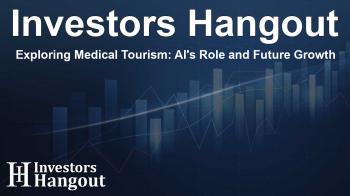Exploring Medical Tourism: AI's Role and Future Growth

The Thriving World of Medical Tourism
The medical tourism sector is experiencing remarkable growth, projected to add USD 85.9 billion between 2024 and 2028. This expansion can be attributed to the increasing demand for affordable healthcare services and advanced treatment options available across borders. With an astounding compound annual growth rate (CAGR) of 32.11%, this market is resonating with patients worldwide seeking quality healthcare at lower costs than available in their home countries.
Impact of Technology on Medical Tourism
The Role of AI
Artificial Intelligence (AI) is reshaping the landscape of medical tourism in several ways. Hospitals and healthcare providers are integrating AI-driven technology to enhance patient experiences. From personalized healthcare plans to predictive analytics, AI helps streamline processes, making medical travel more efficient. This technological evolution also supports various healthcare segments, including robotic surgeries and telemedicine, enabling patients to receive care from the best specialists while minimizing travel barriers.
Challenges in Medical Tourism
Despite the growth opportunities, the industry faces challenges that could hinder its progress. Infrastructure gaps in many developing countries significantly impact the quality of care provided. Patients often face difficulties like language barriers, navigating local healthcare systems, and ensuring follow-up care upon returning home. Moreover, patients' concerns about hygiene and safety play a significant role in their choice of medical travel destinations.
Key Drivers of Growth in the Medical Tourism Sector
Several factors contribute to the burgeoning medical tourism marketplace. Primarily, the rising costs of healthcare in developed nations lead many patients to seek treatment overseas. Common procedures that attract medical tourists include surgical and cosmetic interventions, such as dental surgeries, cardiac procedures, and various elective treatments. Accessibility and affordability facilitate the appeal of destinations known for their high-quality healthcare services without the steep price tag.
Growing Popularity of Cosmetic Procedures
Cosmetic medical tourism has become a popular niche within the industry, with patients traveling for aesthetic surgeries from liposuction to breast augmentation. This sector of medical tourism is significantly influenced by the quest for better pricing and the high standards of care and technology found in alternative healthcare markets. Clinics specializing in cosmetic procedures often draw international clients, thanks to their state-of-the-art facilities and renowned specialists.
Market Overview and Segmentation
The medical tourism market encompasses various segments based on treatment type and service sectors. Major segments include cardiovascular care, cosmetic treatments, orthopedics, and fertility treatments. Each of these segments sees a unique set of trends that reflect consumer demand and advancements in medical technology. Understanding these sub-markets is critical for stakeholders aiming to navigate this complex landscape.
Regional Insights
Regions like North America remain top contributors to the market, constituting about 33% of medical tourism. However, Asia-Pacific is swiftly gaining traction due to its competitive and cost-effective healthcare offerings. Nations such as India and Thailand are often highlighted as premier destinations due to their advanced medical facilities, trained professionals, and attractive pricing arrangements.
Future of Medical Tourism
As we look forward to the coming years, the medical tourism market is expected to evolve further, harnessing the power of AI and digital health innovations. Increasing global healthcare expenditures and a patient-centric approach that prioritizes affordability and quality are shaping this shift. Moreover, emerging technologies will likely facilitate better patient education and improve access to necessary information about treatment options and provider performance.
Frequently Asked Questions
What is medical tourism?
Medical tourism refers to individuals traveling abroad to receive medical, dental, or surgical treatments, typically due to lower costs and quality care.
How does AI influence medical tourism?
AI enhances medical tourism by offering personalized care, predictive analytics for better outcomes, and improving patient experiences through advanced technologies.
What are the common reasons for traveling for medical care?
Patients seek medical care abroad for affordability, advanced technology, shorter waiting times, and to access specialized treatments not available in their home countries.
What challenges do medical tourists face?
Challenges include language barriers, inadequate infrastructure, navigating foreign healthcare systems, and post-treatment follow-up.
Which countries are popular for medical tourism?
Popular destinations include India, Thailand, Mexico, and several Eastern European countries, known for their advanced healthcare facilities and lower treatment costs.
About The Author
Contact Thomas Cooper privately here. Or send an email with ATTN: Thomas Cooper as the subject to contact@investorshangout.com.
About Investors Hangout
Investors Hangout is a leading online stock forum for financial discussion and learning, offering a wide range of free tools and resources. It draws in traders of all levels, who exchange market knowledge, investigate trading tactics, and keep an eye on industry developments in real time. Featuring financial articles, stock message boards, quotes, charts, company profiles, and live news updates. Through cooperative learning and a wealth of informational resources, it helps users from novices creating their first portfolios to experts honing their techniques. Join Investors Hangout today: https://investorshangout.com/
The content of this article is based on factual, publicly available information and does not represent legal, financial, or investment advice. Investors Hangout does not offer financial advice, and the author is not a licensed financial advisor. Consult a qualified advisor before making any financial or investment decisions based on this article. This article should not be considered advice to purchase, sell, or hold any securities or other investments. If any of the material provided here is inaccurate, please contact us for corrections.

